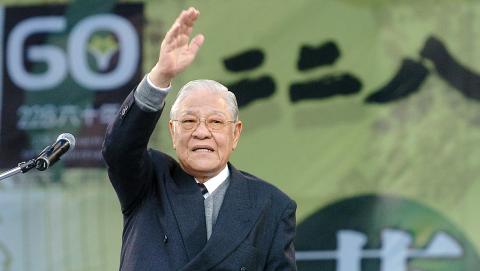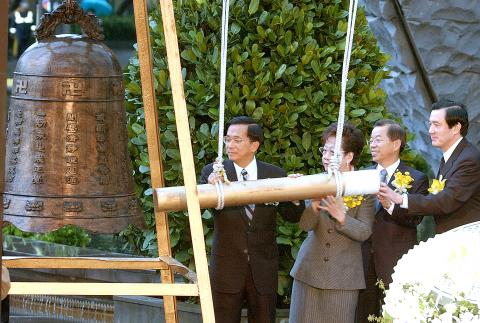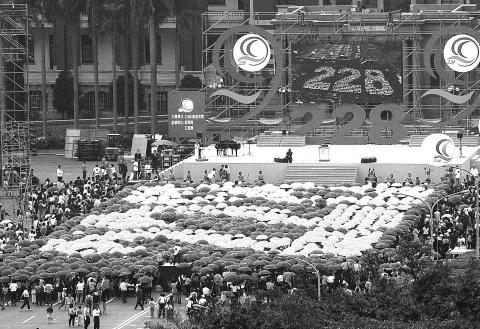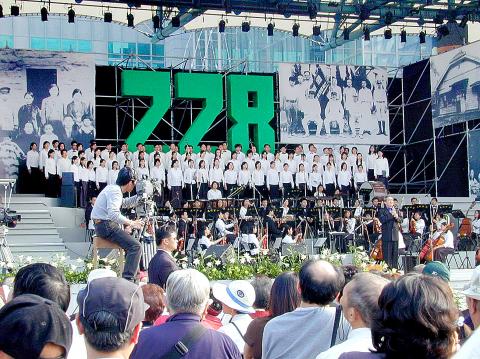Feb. 25 to March 3
After Lee Teng-hui (李登輝) became the first president to publicly apologize for the 228 Incident in 1995, he added that this was just the beginning.
“We need to publicize the truth behind the events, compensate the victims, designate a memorial day, heal our people’s spirits and rebuild their dignity,” he said. “These will all happen in the near future.”

Photo: Liu Hsin-te, Taipei Times
Although activists and opposition politicians had been clamoring for the previous decade for the government to at least acknowledge the 1947 anti-government uprising and subsequent brutal crackdown, it remained a taboo topic well into the 1980s. Between 1948 and 1984, the incident was only mentioned only four times in the major newspapers of Taiwan Shin Sheng Daily News (台灣新生報), United Daily News (聯合報) and China Times (中國時報).
Things started to change after the lifting of martial law in 1987. In 1988, the government made public the original investigative report on the incident conducted in 1947. On Feb. 27, 1990, the Legislative Yuan observed a minute of silence for the victims. The Executive Yuan set up a 228 investigative task force in 1991, releasing a report the subsequent year, and plans were made to set up a monument, memorial park and museum in Taipei.
However, the people still wanted an official apology. Lee declined to do so at first, telling reporters in 1988 that looking into the 228 Incident should be a task for historians, and that people should bury the hatchet and look toward the future instead of the past.

Photo: Liu Hsin-te, Taipei Times
After he finally obliged, things started to move quickly.
COMPENSATION ACT

Photo: Chu Yu-ping,Taipei Times
Just over a month after Lee’s historic gesture, the 228 Incident Disposition and Compensation Act (228事件處理及賠償條例) went into effect on Apr. 7, 1995. This act has been modified several times over the years.
The first article describing the purpose of the act has changed little — the first version listed “dealing with compensatory matters, enhancing citizen knowledge on the truth behind the incident, pacifying historical wounds and fostering racial integration,” while the current version adds “implementing historical education and clarifying attribution of responsibility.”
The fourth article established the 228 Peace Memorial Day, fulfilling the wishes of the 228 Peace Day Association (22八和平日促進會), which had been fighting for this goal since it was co-founded by noted democracy activist Deng Nan-jung (鄭南榕) in 1987.

Photo: Tseng Te-feng, Taipei Times
The third article laid the basis for establishing the Memorial Foundation of 228 (228事件紀念基金會), also stipulating that victims or their family members should make up at least one-fourth of the board of directors.
Compensation would be awarded to the family members of victims who had died or disappeared; who had been injured, detained or sentenced; who had suffered loss of property, health or reputation; and any other causes to be determined by the foundation.
As of June last year, the Liberty Times (the Taipei Times’ sister newspaper) reported that 2,312 cases related to the 228 Incident were approved for compensation. This does not include settlements given to White Terror and other Martial Law-era victims.
On the 49th anniversary of the incident in 1996, Taipei New Park (台北新公園) was renamed 228 Peace Memorial Park (228和平紀念公園). The radio station in the park, which was used by angry protestors to broadcast accusations against the government in the aftermath of the incident, opened its doors as the Taipei 228 Memorial Museum (台北22八紀念館) a year later.
The park’s memorial monument was co-designed by architect Cheng Tzu-tsai (鄭自才), who had been involved in the 1970 assassination attempt on former president Chiang Ching-kuo (蔣經國) in New York. Cheng filed the design from jail, as he was serving a one-year sentence for illegally entering Taiwan after decades of exile. While it was unveiled in 1995 and served as the site for Lee’s apology, it took over 30 meetings to finalize the 642-word plaque text, leading to the memorial not being formally dedicated until 1997.
SITES OF REMEMBRANCE
The monument in 228 Peace Memorial Park is actually Taiwan’s sixth such structure, each preceding one with its own story to tell.
The first was built in 1989 to replace a statue of Wu Feng (吳鳳), which had been destroyed by Aboriginal activists a year earlier. For many decades they had resented the government-propagated tale of how Wu sacrificed himself to stop “bloodthirsty” Aboriginal people from headhunting. Aboriginal rights groups had issued an “Indigenous Rights Declaration” in 1987 and the movement was in high gear.
The government obviously did not like the 228 activists’ plans to build a monument on the site, so they moved quickly and installed a peace bell. The activists ended up erecting it in another site in Chiayi. News reports show that the site was vandalized and damaged several times during the construction process. Monument designer Chan San-yuan (詹三原) was jailed (under other pretenses) in 1992, presumably for his role in the incident.
The first government-supported monument is located in Pingtung’s Chungshan Park (中山公園). It was built in 1992, when Pingtung’s mayor was current Premier Su Tseng-chang (蘇貞昌).
Kaohsiung’s Shoushan National Natural Park (壽山國家自然公園) includes the site where negotiations between civilian representatives and government forces broke down. The representatives were arrested or executed, and Kaohsiung became the first area in Taiwan to be suppressed by military force. A memorial was built there in 1993.
Finally, the memorial in Keelung’s Badu (八堵) train station was built in 1994 to commemorate an incident that took place during the government crackdown on the uprising. On Mar. 11, 1947, soldiers shot and killed four or five railway station workers and took away another 13, who were never seen again. The monument was sponsored by the descendants of station master Li Tan-hsiu (李丹修) and his deputy Hsu Chao-tsung (許朝宗).
Today, there are more than 20 monuments for the 228 Incident across Taiwan.
Starting from the incident’s 60th anniversary, the flag on the Presidential Office has flown at half mast every Feb. 28. Prior to that, this only happened when “persons of significance died or major tragedies occurred.”
Taiwan in Time, a column about Taiwan’s history that is published every Sunday, spotlights important or interesting events around the nation that have anniversaries this week.

The 1990s were a turbulent time for the Chinese Nationalist Party’s (KMT) patronage factions. For a look at how they formed, check out the March 2 “Deep Dives.” In the boom years of the 1980s and 1990s the factions amassed fortunes from corruption, access to the levers of local government and prime access to property. They also moved into industries like construction and the gravel business, devastating river ecosystems while the governments they controlled looked the other way. By this period, the factions had largely carved out geographical feifdoms in the local jurisdictions the national KMT restrained them to. For example,

The remains of this Japanese-era trail designed to protect the camphor industry make for a scenic day-hike, a fascinating overnight hike or a challenging multi-day adventure Maolin District (茂林) in Kaohsiung is well known for beautiful roadside scenery, waterfalls, the annual butterfly migration and indigenous culture. A lesser known but worthwhile destination here lies along the very top of the valley: the Liugui Security Path (六龜警備道). This relic of the Japanese era once isolated the Maolin valley from the outside world but now serves to draw tourists in. The path originally ran for about 50km, but not all of this trail is still easily walkable. The nicest section for a simple day hike is the heavily trafficked southern section above Maolin and Wanshan (萬山) villages. Remains of

With over 100 works on display, this is Louise Bourgeois’ first solo show in Taiwan. Visitors are invited to traverse her world of love and hate, vengeance and acceptance, trauma and reconciliation. Dominating the entrance, the nine-foot-tall Crouching Spider (2003) greets visitors. The creature looms behind the glass facade, symbolic protector and gatekeeper to the intimate journey ahead. Bourgeois, best known for her giant spider sculptures, is one of the most influential artist of the twentieth century. Blending vulnerability and defiance through themes of sexuality, trauma and identity, her work reshaped the landscape of contemporary art with fearless honesty. “People are influenced by

Ten years ago, English National Ballet (ENB) premiered Akram Khan’s reimagining of Giselle. It quickly became recognized as a 21st-century masterpiece. Next month, local audiences get their chance to experience it when the company embark on a three-week tour of Taiwan. Former ENB artistic director Tamara Rojo, who commissioned the ballet, believes firmly that if ballet is to remain alive, works have to be revisited and made relevant to audiences of today. Even so, Khan was a bold choice of choreographer. While one of Britain’s foremost choreographers, he had never previously tackled a reimagining of a classical ballet, so Giselle was